| Bamboo frame structure 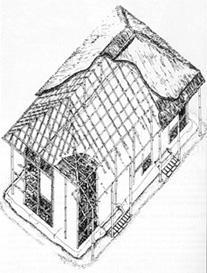 The bamboo houses of the plains are essentially ground level
dwellings, unlike those built on hilly terrain which have floor platforms raised on stilts
(fig.98). the structure of these houses consists of whole bamboo posts embedded vertically
in the ground, and located around a raised rectangular platform of earth filling which is
rammed hard and plastered with clay. These post may be single whole culms of a fairly
large diameter, large wall thickness, and with short internodes. They are effective
load-bearing members which resist deflection or bending on loading. Composite posts are
also made by lashing together whole culms of a lesser diameter. Beams of whole bamboo
culms are placed to link the posts around the perimeter of the rectangle. The commonly
used joint in this case is the saddle joint (fig.99) The bamboo houses of the plains are essentially ground level
dwellings, unlike those built on hilly terrain which have floor platforms raised on stilts
(fig.98). the structure of these houses consists of whole bamboo posts embedded vertically
in the ground, and located around a raised rectangular platform of earth filling which is
rammed hard and plastered with clay. These post may be single whole culms of a fairly
large diameter, large wall thickness, and with short internodes. They are effective
load-bearing members which resist deflection or bending on loading. Composite posts are
also made by lashing together whole culms of a lesser diameter. Beams of whole bamboo
culms are placed to link the posts around the perimeter of the rectangle. The commonly
used joint in this case is the saddle joint (fig.99) where the top of the post is cut out to
form a saddle on which the beam rests and the joint is secured by binding it with bamboo
splits, cane splits or lengths of galvanised iron wire. There are many variations of the
saddle joint (figs.100,101). Tie beams are sometimes added between corresponding sets of
posts on the longer sides of the rectangular plan (figs.102-104). where the top of the post is cut out to
form a saddle on which the beam rests and the joint is secured by binding it with bamboo
splits, cane splits or lengths of galvanised iron wire. There are many variations of the
saddle joint (figs.100,101). Tie beams are sometimes added between corresponding sets of
posts on the longer sides of the rectangular plan (figs.102-104).
The roof
The roof structure is normally made of
prefabricated panels composed of rafters and purlins lashed together and covered with
grass thatch (fig. 105). 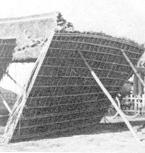 The
panels are made on the ground near the house, and then hoisted above the post and beam
structure and secured by binding them to the beams and at the ridges so that they support
and lean against each other. These roof panels are either rectangular or trapezoidal, and
in either case the triangular openings at the ends of the prism formed by the roof
structure have to be filled or covered. In the case of the former structure the two end
walls are extended above the beam level to meet the roof, and in the latter triangular
thatched roof panels are fixed along the slope created by the inclined edges of the
trapezoidal panels and lashed in place. The
panels are made on the ground near the house, and then hoisted above the post and beam
structure and secured by binding them to the beams and at the ridges so that they support
and lean against each other. These roof panels are either rectangular or trapezoidal, and
in either case the triangular openings at the ends of the prism formed by the roof
structure have to be filled or covered. In the case of the former structure the two end
walls are extended above the beam level to meet the roof, and in the latter triangular
thatched roof panels are fixed along the slope created by the inclined edges of the
trapezoidal panels and lashed in place.
The walls
The wall structure rests on the posts
around the house. Lengths of whole bamboo of a smaller diameter are lashed on to the posts
horizontally, at various heights, uniformally spaced from the bottom to the top of the
posts. These run all around the house interrupted only to provide the openings necessary
for the doorways and windows. These members are whole culms of a smaller diameter and
windows.  These members are whole
culms of a smaller diameter and wall thickness and the internode distance is also much
larger than those of the posts. The upper tapering part of bamboo culms which are
generally weaker than the basal part are used for these members. These members are whole
culms of a smaller diameter and wall thickness and the internode distance is also much
larger than those of the posts. The upper tapering part of bamboo culms which are
generally weaker than the basal part are used for these members.  Woven bamboo mats (fig.106,107), made either from
flattened bamboo boards or from coarse splits, are held against the horizontal whole
bamboo members by lengths of longitudinal halves or quarters of bamboo running parallel to
each of these members and lashed to the existing horizontals through the mat. These walls
are plastered with mud or left exposed without surface treatment. Woven bamboo mats (fig.106,107), made either from
flattened bamboo boards or from coarse splits, are held against the horizontal whole
bamboo members by lengths of longitudinal halves or quarters of bamboo running parallel to
each of these members and lashed to the existing horizontals through the mat. These walls
are plastered with mud or left exposed without surface treatment. |

 The bamboo houses of the plains are essentially ground level
dwellings, unlike those built on hilly terrain which have floor platforms raised on stilts
(fig.98). the structure of these houses consists of whole bamboo posts embedded vertically
in the ground, and located around a raised rectangular platform of earth filling which is
rammed hard and plastered with clay. These post may be single whole culms of a fairly
large diameter, large wall thickness, and with short internodes. They are effective
load-bearing members which resist deflection or bending on loading. Composite posts are
also made by lashing together whole culms of a lesser diameter. Beams of whole bamboo
culms are placed to link the posts around the perimeter of the rectangle. The commonly
used joint in this case is the saddle joint (fig.99)
The bamboo houses of the plains are essentially ground level
dwellings, unlike those built on hilly terrain which have floor platforms raised on stilts
(fig.98). the structure of these houses consists of whole bamboo posts embedded vertically
in the ground, and located around a raised rectangular platform of earth filling which is
rammed hard and plastered with clay. These post may be single whole culms of a fairly
large diameter, large wall thickness, and with short internodes. They are effective
load-bearing members which resist deflection or bending on loading. Composite posts are
also made by lashing together whole culms of a lesser diameter. Beams of whole bamboo
culms are placed to link the posts around the perimeter of the rectangle. The commonly
used joint in this case is the saddle joint (fig.99) where the top of the post is cut out to
form a saddle on which the beam rests and the joint is secured by binding it with bamboo
splits, cane splits or lengths of galvanised iron wire. There are many variations of the
saddle joint (figs.100,101). Tie beams are sometimes added between corresponding sets of
posts on the longer sides of the rectangular plan (figs.102-104).
where the top of the post is cut out to
form a saddle on which the beam rests and the joint is secured by binding it with bamboo
splits, cane splits or lengths of galvanised iron wire. There are many variations of the
saddle joint (figs.100,101). Tie beams are sometimes added between corresponding sets of
posts on the longer sides of the rectangular plan (figs.102-104).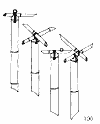

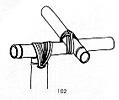

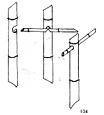
 The
panels are made on the ground near the house, and then hoisted above the post and beam
structure and secured by binding them to the beams and at the ridges so that they support
and lean against each other. These roof panels are either rectangular or trapezoidal, and
in either case the triangular openings at the ends of the prism formed by the roof
structure have to be filled or covered. In the case of the former structure the two end
walls are extended above the beam level to meet the roof, and in the latter triangular
thatched roof panels are fixed along the slope created by the inclined edges of the
trapezoidal panels and lashed in place.
The
panels are made on the ground near the house, and then hoisted above the post and beam
structure and secured by binding them to the beams and at the ridges so that they support
and lean against each other. These roof panels are either rectangular or trapezoidal, and
in either case the triangular openings at the ends of the prism formed by the roof
structure have to be filled or covered. In the case of the former structure the two end
walls are extended above the beam level to meet the roof, and in the latter triangular
thatched roof panels are fixed along the slope created by the inclined edges of the
trapezoidal panels and lashed in place. These members are whole
culms of a smaller diameter and wall thickness and the internode distance is also much
larger than those of the posts. The upper tapering part of bamboo culms which are
generally weaker than the basal part are used for these members.
These members are whole
culms of a smaller diameter and wall thickness and the internode distance is also much
larger than those of the posts. The upper tapering part of bamboo culms which are
generally weaker than the basal part are used for these members.  Woven bamboo mats (fig.106,107), made either from
flattened bamboo boards or from coarse splits, are held against the horizontal whole
bamboo members by lengths of longitudinal halves or quarters of bamboo running parallel to
each of these members and lashed to the existing horizontals through the mat. These walls
are plastered with mud or left exposed without surface treatment.
Woven bamboo mats (fig.106,107), made either from
flattened bamboo boards or from coarse splits, are held against the horizontal whole
bamboo members by lengths of longitudinal halves or quarters of bamboo running parallel to
each of these members and lashed to the existing horizontals through the mat. These walls
are plastered with mud or left exposed without surface treatment.